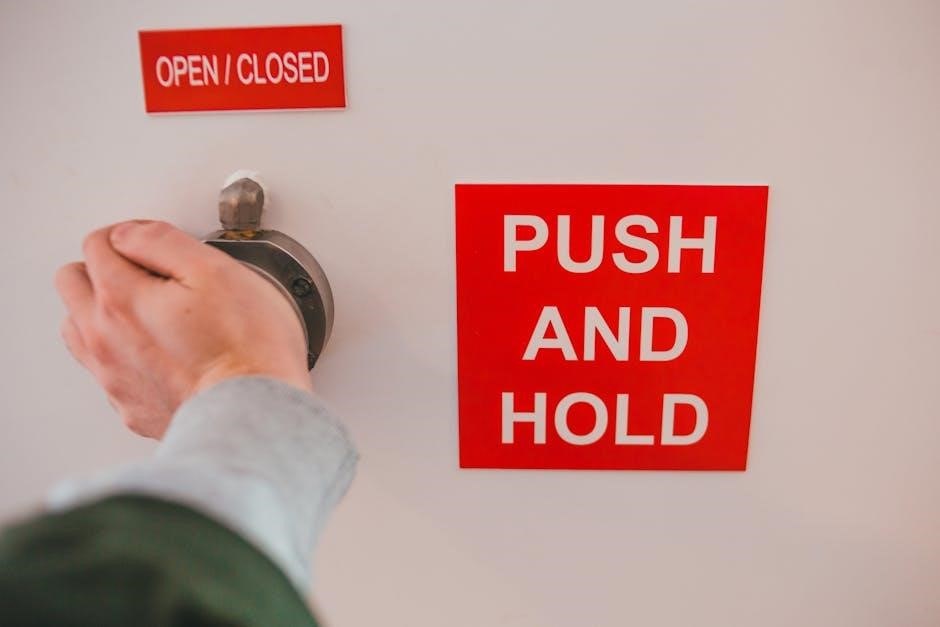Manual handling involves lifting, lowering, pushing, pulling, or carrying loads, posing risks to health. The hierarchy of control offers a structured approach to minimizing these risks effectively.
1.1 Overview of Manual Handling
Manual handling refers to any activity requiring the use of bodily force to lift, lower, push, pull, carry, move, hold, or restrain a load. It is a common task across various industries, from manufacturing to healthcare. Hazardous manual handling occurs when these activities pose a risk of injury, particularly to the musculoskeletal system. The 1992 Manual Handling Operations Regulations emphasize the importance of identifying and mitigating risks associated with manual handling. Understanding manual handling is crucial for preventing work-related injuries, as improper techniques or excessive loads can lead to strains, sprains, or long-term health issues. Employers and employees must assess tasks, implement control measures, and adopt safe practices to minimize risks. This section provides a foundational understanding of manual handling, setting the stage for exploring the hierarchy of control measures.

1.2 Importance of the Hierarchy of Control in Manual Handling
The hierarchy of control is a critical framework for managing manual handling risks effectively. It prioritizes control measures, starting with the most effective—elimination—and progressing to less effective options like personal protective equipment (PPE). This structured approach ensures that employers and employees address risks systematically, reducing the likelihood of injury. By following the hierarchy, workplaces can minimize the physical and financial costs associated with manual handling injuries. The hierarchy also aligns with legal requirements, such as the 1992 Manual Handling Operations Regulations, ensuring compliance and promoting a proactive safety culture. Its importance lies in its ability to guide decision-making, optimize resource allocation, and create safer working environments. Ultimately, the hierarchy of control is essential for protecting worker health and fostering operational efficiency in industries where manual handling is unavoidable.

The Hierarchy of Control in Manual Handling
The hierarchy of control outlines a prioritized approach to managing manual handling risks. It includes elimination, substitution, engineering controls, administrative controls, and PPE. This framework helps mitigate risks effectively.
2.1 Elimination of Manual Handling
Elimination is the most effective control measure in the hierarchy, involving the complete removal of manual handling tasks. This can be achieved by redesigning processes to avoid handling loads altogether. For example, using mechanical aids like conveyor belts or automated systems can eliminate the need for manual lifting or carrying. Employers should assess tasks to identify opportunities for elimination, prioritizing tasks that pose the highest risk of injury. By eliminating manual handling, workplaces can significantly reduce the risk of musculoskeletal disorders and create a safer environment. This approach not only protects employees but also enhances operational efficiency and reduces costs associated with workplace injuries. Elimination should always be the first consideration when addressing manual handling risks.

2.2 Substitution of Manual Handling
Substitution involves replacing hazardous manual handling tasks with safer alternatives. This step is applied when elimination isn’t possible. Employers can introduce mechanical aids, such as hoists or trolleys, to reduce physical exertion. Additionally, substituting heavy materials with lighter alternatives can minimize strain. Task redesign, such as adjusting workflows to reduce repetitive movements, is another effective strategy. Substitution aims to lower the risk of injury by reducing the physical demands of manual handling. It is essential to assess tasks thoroughly to identify suitable substitutes and ensure proper implementation. By substituting high-risk tasks, workplaces can create a safer environment while maintaining productivity. This approach aligns with the hierarchy of control, prioritizing safer methods before relying on less effective measures like administrative controls or PPE.
2.3 Engineering Controls for Manual Handling
Engineering controls are physical modifications to the workplace or equipment to reduce manual handling risks. These controls aim to eliminate or minimize physical strain by redesigning tasks or tools. Examples include installing mechanical aids, such as pulleys or lifts, to reduce lifting efforts. Adjustable workstations and ergonomic equipment, like height-adjustable conveyor belts, can also alleviate strain. Engineering controls are preferred because they are inherently safer and more reliable than administrative or PPE-based solutions. They address the root causes of hazards, creating a safer working environment. Implementing these controls often requires collaboration between engineers, safety professionals, and employees to ensure practical and effective solutions. By prioritizing engineering controls, organizations can significantly reduce the risk of manual handling injuries and improve overall workplace safety. These measures are a cornerstone of the hierarchy of control, offering long-term benefits for worker health and productivity.
2.4 Administrative Controls for Manual Handling
Administrative controls are workplace policies and procedures designed to reduce the risks associated with manual handling. These controls focus on managing how tasks are performed rather than eliminating the need for manual handling entirely. Examples include implementing safe work practices, rotating tasks to avoid repetitive strain, and providing regular breaks to reduce fatigue. Training programs that teach proper lifting techniques and injury prevention strategies also fall under administrative controls. While these measures are effective, they rely on worker compliance and may not entirely eliminate the risk of injury. Administrative controls are often used in conjunction with engineering controls to create a safer working environment. They are an essential part of the hierarchy of control, offering practical solutions to mitigate manual handling risks when elimination or substitution is not feasible.
2.5 Personal Protective Equipment (PPE) in Manual Handling
Personal Protective Equipment (PPE) is the last line of defense in the hierarchy of control for manual handling. It is used when other control measures are not feasible or sufficient to reduce risks. Common examples of PPE for manual handling include gloves to improve grip and prevent cuts, back supports to reduce strain during lifting, and footwear with traction to prevent slips. While PPE does not eliminate the hazard, it helps minimize the risk of injury. Employers are responsible for assessing the workplace to determine if PPE is necessary and ensuring that workers are trained in its proper use. However, reliance on PPE alone is not considered best practice, as it does not address the root causes of manual handling risks. PPE should always be used in conjunction with other control measures for optimal workplace safety.

Implementing the Hierarchy of Control in the Workplace
Implementing the hierarchy involves conducting risk assessments, providing training, and ensuring employees understand and follow control measures to minimize manual handling risks effectively.
3.1 Conducting a Manual Handling Risk Assessment
A manual handling risk assessment is a systematic process to identify and evaluate hazards associated with manual tasks. It involves analyzing factors such as the load’s weight, size, and stability, as well as the task’s frequency, duration, and posture requirements. Employers must consider the individual capabilities of workers, including their physical strength and any pre-existing conditions. The assessment should prioritize control measures based on the hierarchy of control, aiming to eliminate or reduce risks. Consultation with employees is crucial to ensure the assessment reflects real workplace conditions. Once risks are identified, employers must implement controls and review the assessment regularly to ensure ongoing safety. This process is essential for protecting workers from injuries and ensuring compliance with health and safety regulations.
3.2 Training and Awareness for Employees
Training and awareness are critical components in managing manual handling risks. Employers must provide employees with comprehensive training on the hierarchy of control, emphasizing the importance of eliminating or reducing manual handling tasks. This includes teaching proper lifting techniques, the use of equipment, and how to identify and report potential hazards. Regular refresher courses ensure that employees remain informed about safety practices and updates in regulations. Awareness campaigns can further reinforce safe manual handling behaviors, encouraging employees to take an active role in their own safety and that of their colleagues. By fostering a culture of safety, organizations can significantly reduce the likelihood of injuries and promote a healthier workplace environment.

Leave a Reply
You must be logged in to post a comment.